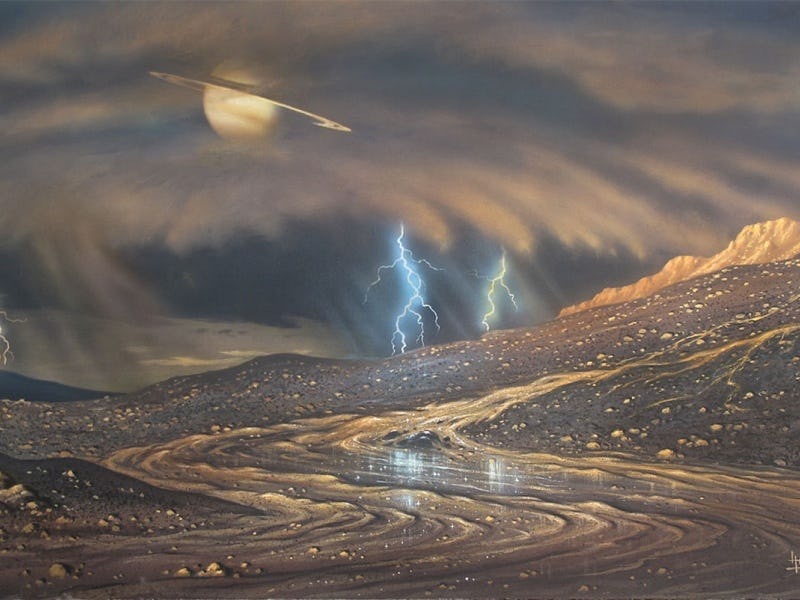Titan Has 300-Foot Electrically Charged Sand Dunes

The sand particles on Titan, Saturn’s largest moon, can carry an electric charge that allows them to statically cling together in massive dunes and resist atmospheric conditions that would otherwise budge them, according to new findings published Monday in the journal Nature Geoscience. The new study suggests that Titan could potentially hold a charge for months at a time, which could explain why sand formations on Titan’s surface appear to exist without regard for which way the literal wind is blowing.
When cosmic winds reach about 15 mph, non-silica particles become dislodged from the surface and begin to collide, accumulating a frictional charge as they go. Researchers at the Georgia Institute of Technology recreated surface conditions inside a pressurized tube and found that all the non-silica granules became charged, so much so that a small percentage actually remained clinging to the inside, refusing to come out. The same simulation was conducted for Earth conditions, with boring Earth particles comprising boring Earth ash and sand that do not do anything special, but to little effect.
“If you’ve ever tried to crumple up Styrofoam, it kicks off little particles that stick to each other,” study co-author and Georgia Tech geophysicist Josef Dufek tells Inverse. “[In the lab] the few grains sticking together were the size of a pill bug, or maybe a pea.”
Earth is boring.
The experiment doesn’t directly address Titan’s habitability — always a buzzy topic when it comes to our solar system’s various moons — but coauthor George McDonald says it’s conceivable that these kinds of electrostatic charges could be an energy source for chemical reactions that could draw oxygen from Titan’s inert water ice surface. McDonald explains that this could be a way to free up oxygen, which when combined with the abundant nitrogen, carbon, and hydrogen already in Titan’s atmosphere could mean it has all the necessary ingredients for life.
Earth sand does carry a small charge, but nothing that would result in the 300-foot sand castles found on Titan, where the electrostatic forces increase the particles’ clumping by a full order of magnitude when the wind is powerful enough. On Earth, the grains are heavier and are subject to water in the atmosphere. This is basically a wet blanket that dissipates the charge faster, which is why you need water to make the particles in an Earth sand castle stay clumped together instead of getting these rad formations that build themselves. Titan is the only environment we know of where this phenomenon occurs — but there could easily be other planets and moons we haven’t been able to explore yet.
“It opens up a whole new realm of understanding geological processes in other bodies that haven’t really been explored at all,” says lead author Josh Mendez Harper.
Abstract
Triboelectric, or frictional, charging is a ubiquitous yet poorly understood phenomenon in granular flows. Recognized in terrestrial volcanic plumes and sand storms, such electrification mechanisms are possibly present on Titan. There, dunes and plains of low-density organic particles blanket extensive regions of the surface. Unlike Earth, Titan hosts granular reservoirs whose physical and chemical properties possibly enhance the effects of charging on particle motion. Here we demonstrate in laboratory tumbler experiments under atmospheric conditions and using organic materials analogous to Titan that Titan sands can readily charge triboelectrically. We suggest that the resulting electrostatic forces are strong enough to promote aggregation of granular materials and affect sediment transport on Titan. Indeed, our experiments show that electrostatic forces may increase the saltation threshold for grains by up to an order of magnitude. Efficient electrification may explain puzzling observations on Titan such as the mismatch between dune orientations and inferred wind fields. We conclude that, unlike other Solar System bodies, nanometre-scale electrostatic processes may shape the geomorphological features of Titan across the moon’s surface.